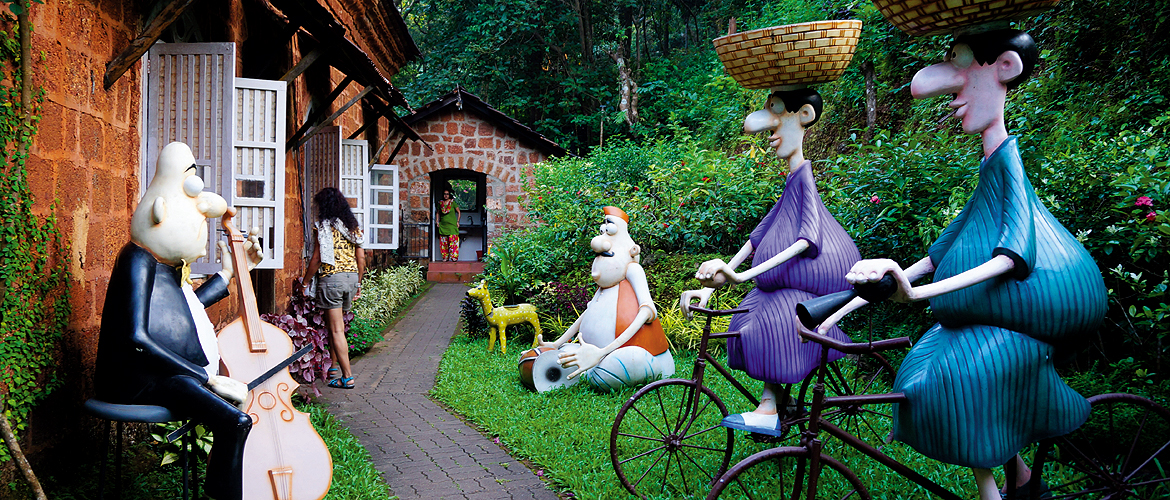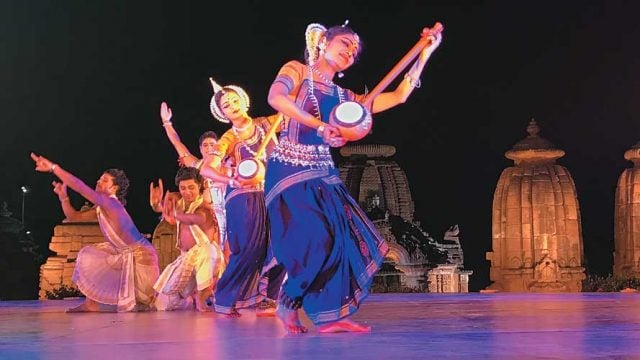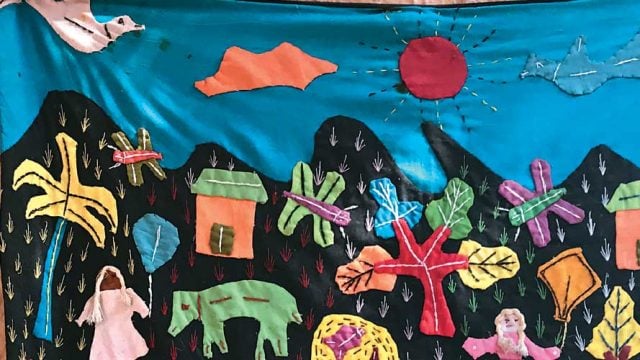Everyone goes to Goa for a holiday. We two schmucks go there to work. Eating at
The Goa Tourism Development Corporation (GTDC) was launching hot-air ballooning in South Goa, and Heli Tours and Duck Boat Tours from Panjim with plans to develop Mayem Lake. The same lake that generations of Goans grew up going for picnics to—it’s so old, Hum Bane Tum Bane from Ek Duje Ke Liye was shot there. Plans were afoot to develop a clutch of five islands off Vasco—Grande St George, Pequeno, Conco and Bhindo. Goa’s year-round festivities were being promoted—Bonderam Festival at Diwar Island (April-May), Sao Joao in June (where Goans go an’ jump in the well), Pattoleochem Fest at Socorro in August where the steamed pattoleo (rice and jaggery dumpling) is the star. There’s even a Ponsachem (jackfruit) fest and Touxeachem (cucumber) fest. Yes, food is indeed a celebration here.
A new addition to Goa’s cultural scene (besides Sunaparanta in Panjim and the Houses of Goa Museum near Porvorim) is MoG or the Museum of Goa. Blue roadside mermaids guided us to the museum of contemporary art in Pilerne set up by local artist Subodh Kerkar. Working with a wide range of media in his installations, his abiding muse remains Goa—its sea, coastline, surroundings, rich culture and heritage. Collaborating with the ocean, he immersed antique ceramic plates in its waters and allowed oysters, barnacles and shells to create artworks on old china. Chipping and slicing through layers of red, yellow and blue oxides painted over time, Kerkar turned sections of old walls into his canvas. Other local artists, too, gave rare insights into Goa. Shilpa Naik’s Mosaic paid tribute to the mosaic tiles ubiquitous in most Goan homes. We discovered that Goa never had any ceramic industry and the chips were actually ballast brought by Portuguese and Chinese ships!

Santosh Morajkar’s The Motorcycle Pilot celebrated Goa as the only place in India where motorcycles are used as taxis. There are nearly 10,000 of them here. The first motorcycle taxi stand was at the base of Pilot Hill near Panjim Church. Since the lighthouse on the hill helped ‘pilot’ ships in the Mandovi river, the motorcycle taxis were nicknamed ‘pilots’. Apart from MoG Sundays dedicated to Talks, Films, Expressions (11am-1pm), the museum hosts frequent jazz and music events. Kerkar also leads free-wheeling walks at Saligao, Aldona, Siolim or any village a short drive away. His private jaunts turned professional when Bambi, the manager of the lovely seaside cottage Ahilya by the Sea, asked him to lead these walks for guests.

We set off with Kerkar from Birdsong, a charming 200-year-old renovated villa in the hinterland of Moira. With peacocks calling and mist rising from the roads and yellow paddy fields, we walked past lovely homes to explore Goa anew…
Kerkar pointed out the scalloped tiles fringing the roofs of homes. Apparently, the clay tiles were hand-patted on the thigh, giving them a distinct curvature—narrow on one side and broad on the other. The tile’s shape depended on a person’s avoirdupois! When the Portuguese came, the shell windows were already in use. In his book Goa and the Blue Mountains, 18th-century traveller Richard Burton is dismissive: “In Goa, there is not even proper glass available and they used seashells for windows.”
It was an unwritten rule that houses could be any colour but white reserved for churches and chapels. Colours were derived from natural pigments—oxides of red and yellow and chuna (lime) mixed with indigo-yielded blue. We walked past locals tending to tendli (ivy gourd) gardens. Kerkar joked that his request to pluck tender tendlis on a previous walk were rebuffed with a stern “They’re kids!” Others watered their red-leaved tambdi bhaji (amaranth). “That’s karith,” he pointed to a small gourd. “It’s very bitter and during Diwali it’s customary to eat karith before you eat sweets, symbolic of keeping the balance of bitter and sweet in life.” Straw and hay figurines of Narakasura were being built on the wayside, to be lit up before Diwali.
Tracing the lineage of what are now considered Indian vegetables, Subodh explained that the Portuguese introduced the tomato, chili, potato, caju, besides sweet potato, chikoo and guava, which came from Peru. The Marathi word for potato comes from Portuguese batata and the guava is called Peru! Bread was also a Portuguese introduction. For the longest time, tomatoes were not eaten by Hindus because they thought it was flesh.
Just like the walk had no script, Bhatti Village in Nerul had no menu. Patrick’s voice quavered passionately, “Oh we have many varieties of fish.” In what was earlier a bhatti (feni factory), barrels and glass decanters share space with 3D stickers of Spiderman and Minnie Mouse amid wall plaques of crabs, lobsters, shrimps and fake flowers. Patrick had us at beef kebab, though we said yes to everything he suggested: white bait rava fry, tisro sukka (clam coconut), saudalo (butterfish), dodyaro (saltpan fish), shark ambotik (sweet sour red gravy), ending with Sera dura, a heavenly Portuguese dessert. “You want Guizad as well—you won’t get it in any restaurant! And I’ve packed the ambotik—heat it tomorrow and eat it with poi. Should I pack some poi?” Patrick called over our retreating shoulders as we staggered out, heavy-bellied and weak-kneed.

Locals take great pride in their culinary heroes—be it Anton in Nachinola or Eldridge Lobo at Eldou’s in Siolim, Sabita Fernandes at Amigos for crab hunting and Jurassic crab, cafreal at Florentine’s in Saligao or beef roast and ox tongue at Mafia Cocktails in Pilerne, run by Tony and his famous Sister Cook. But a new generation of chefs at Goa’s shores was tantalising local palates. From Greek cuisine at Thalassa in Vagator to Australian Masterchef Sarah Todd’s restaurant Antares, the making of which is a six-part documentary on SBS, there’s lots to dig in to. Sarah’s Scents of India cocktail seemed right out of a ‘Hassan weds Mehjabeen’ wedding platter and we were happy to have space for dessert and homemade gelato at Baba Au Rhum, doing well in its new location in Anjuna.

Elevar in Ashvem currently boasts the best view and food in town. The latest offering of chef Chris Saleem (of Sublime Morjim fame) treated us to excellent seabass carpaccio, celery fried prawns, papaya-spinach-prawn-lotus root salad, seared bass with pesto tapioca and tandoori prawns over saffron fenugreek risotto. His style is “flashy and mainstream”. Chris says, “I like to give people what they want.” Earlier, we were floored at The Tavern in Fort Tiracol (where Chris was roped in to curate the menu), by exemplary dishes like spaghetti with Tiracol clams and fish fillet with Goan chorizo crust.
Stefan Marias, a Frenchman from South Africa, was now helming the beachside restaurant Go With The Flow, overlooking Baga Creek. With two new outdoor decks, the restaurant spills out of the verandah of the 1928 Filomena Cottage onto the gardens with a make-believe river meandering through, which lights up at night. We wolfed down the Mozambican- style prawn nacional and crispy salt and pepper squid in no time.

On the bustling Candolim-Calangute stretch, the talented Mr Bomra stirs up what some describe as the ‘best Burmese restaurant outside Burma’. On our anonymous visit, the steward clarified, “The chef is Burmese, but the food is not. It’s whatever he likes to make.” Once when some American guests complimented them on the tenderness of the Aldona slow-roast suckling pig, the manager Chris remarked, “Of course it is. It is a suckling pig, it was suckling on its mother when we took it away and slaughtered it. It’s a baby, that’s why it’s so tender.” The horrified guests set down their cutlery and left. Eccentricity rules in Goa.
Like Pondicherry, the fusion of cafeterias and boutiques has caught on in Goa. Latika Khosla’s gorgeous home store, Freedom Tree, in a sea-green Portuguese villa in Sangolda houses hobo-chic crockery, lighting, rugs and furniture. After shopping, step into the adjacent Mustard restaurant, which sums up France and Bengal’s passion for food in one seed—the tiny yet ubiquitous mustard! Conceptualised by Shilpa Sharma and Poonam Singh, the restaurant was actually the villa’s old kitchen. The subtle flavours of East Bengal have been perfectly curated by food historian Pritha Sen and the delicate notes of French cuisine put together by Chef Gregory Bazire. Here, regional specialities like shukto and mochar ghonto rub shoulders with European favourites like tuna pan bagnat and tortelloni a la giardinera.
The tamarind tang of tentul joler sherbet spiked with vodka and a bowl of chilled cucumber latte (Goan cucumbers with Bengali kasundi with mint and mustard sprouts) was the perfect appetiser. We embarked on the smoked chonak fish and kosha mangsho with luchi. Except for certain traditional ingredients, the restaurant follows a zero-mile green philosophy and sources everything locally. You can even buy microgreens to spruce up your salad at home!
Thanks to its faded signage, Satish Warrier’s Gunpowder Restaurant (two houses away from the new Fabindia outlet in Assagao) is a blink-and-miss restaurant set in the backyard of Cursino Villa, an old Portuguese home. Hidden within a leafy compound behind the People Tree design studio, Gunpowder’s Peninsular Kitchen stirs up Syrian Christian beef, chilli pork ribs, crispy natoli (anchovy) fry, appams and regional delicacies.
Complementing Gunpowder’s South Indian flavours is the cool new bar designed by ace mixologist Evgenya Pradznik, a Russian who has mixed her way from Moscow, Mumbai, Delhi, Lebanon to Goa. Behind her teak bar counter, she uses locally sourced turmeric, ginger, spices and fruits. They grow their own thyme, lemongrass, black pepper and 200 pineapple shrubs. “Though we have so many options to choose from, my idea is to stick to classic combinations made with full respect to the main spirit.” Pradznik had some homemade brandy with dry apricot macerated in Riesling stashed away, date liqueur in white rum and mad new concoctions like Pop Fashion, a version of Old Fashioned with an infusion of popcorn in bourbon. We tried the Ginger Cucumber Caipiroska and Tamarind Pineapple Margarita and tottered out.

It seemed like an abandoned, rundown village house except for the vines of Chinese lights wrapping it in a warm firefly glow. The peeling plaster on the mud walls disguised its twilight avatar where people flit in like moths towards lamplight. Soro, strategically located on the Assagao-Siolim road is a New York-style pub masquerading as a Goan village pub. Exposed brick walls, retro posters, multi-coloured geometric floor tiles reminiscent of Mexican homes, bald filament bulbs and stage lights, industrial pipes and quaint relics of juicers make a bold statement. Old-world bar stools propped next to large windows overlook foliage and fields beyond. Named after the Konkani word for liquor, Soro is located in an erstwhile soda factory, making it the ideal place to down or drown sorrows.
“Where next?” asked Savio at Coco Shambhala, a tropical haven near Coco Beach where we had come to try out their new Forest Essentials massages. “Cantare in Saligao, LPK (Love Passion Karma) in Nerul or Cohiba near Aguada?” “No more,” we gasped. “Don’t worry. Soro jivak boro (alcohol is good for life).” As the therapist confirmed our appointment, we cracked up when she said, “I hope you have come on an empty stomach.”
The information
Where to stay
Birdsong, 497 Calzor, Moira. (from `11,000 doubles: 9987962519, birdsonggoa.com)
Ahilya by the Sea, Coco Maia, 787 Nerul-Reis Magos Road, Nerul. (from ₹13,000 per night, mandatory to book for 2 nights, premium charges for one night booking: 011- 41551575, ahilyabythesea.com)
Coco Shambhala, Nerul, Bardez. (from ₹33,000 per two-bedroom villa: 9372267182, cocoshambhala.com)
The Secret Garden, Estrela e Sinos, Saligao. (from approx. ₹4,000: 9552518664)
Lar Amorosa Boutique B&B, House No. 68, Barros Waddo, Sangolda, Bardez. (from approx. ₹5,000: 7888047029, laramorosa.com)
Where to eat & drink
Elevar Beach Bar & Restaurant, Leela Cottages Beach Front, Ashvem, Morjim Road, Mandrem (9130352188, facebook.com/elevarashvem)
Go with the Flow, House No. 614, Calangute Baga (7507771556, gowiththeflowgoa.com)
Soro, The Village Pub, Assagao Baddem Junction (9881934440, facebook.com/SoroGoa)
Bomras, Souza Vaddo, Candolim, Bardez (9767591056, bomras.com)
Thalassa Greek Taverna, Mariketty’s Place, Small Vagator, Ozran (9850033537, thalassagoa.com)
Antares, Small Vagator, Ozran, Vagator (7350011538, antaresgoa.com)
Baba au Rhum, Anjuna (9822866366)
Gunpowder/People Tree, 6 Assagao, Cursino Villa, Saunta Vaddo, Bardez (0832- 2268228, peopletreeonline.com)
Mustard Restaurant/Freedom Tree Store, House No. 78, Mae Dey Deus Vaddo, Chogm Road, Sangolda (facebook.com/ mustardgoa)
What to see & do
Museum of Goa, Pilerne, Bardez (9326119324, museumofgoa.com)
Houses of Goa Museum and Mario Gallery, Torda, Salvador do Mundo, Bardez (0832- 2410711, archgoa.org
art
Birdsong
features





